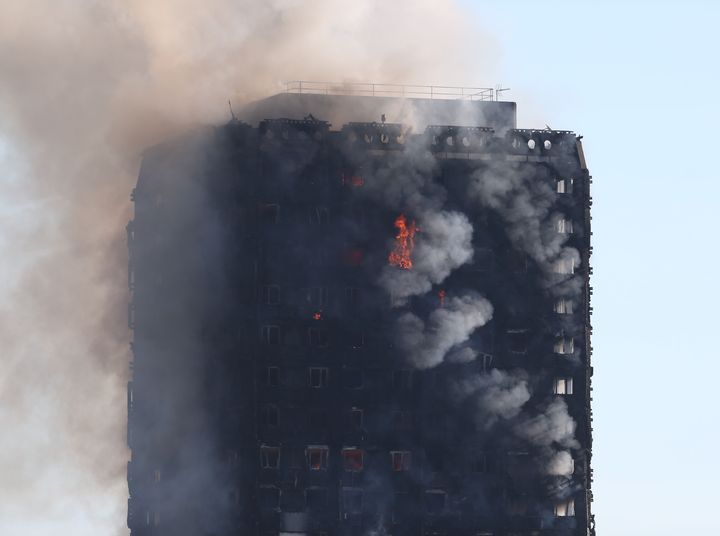
Survivor groups have reacted with anger after a leaked report into the Grenfell Tower fire revealed the blaze would have had “little opportunity” to spread beyond the flat it started in, had the building not been renovated with combustible material.
The 210-page report, which has been prepared as part of the Metropolitan Police Service investigation, concludes that the fire would not have spread beyond flat 16 - where the fire originated on the fourth floor - if the original facade of the building had not been re-clad.
The interim document, leaked to the Evening Standard, was authored by fire investigation experts BRE Global.
In addition to the cladding, the installation of the windows and cavity barriers were also deficient, the report reveals.
Experts found that if the original building had been built to less stringent modern safety standards of fire resistance “it is likely the Tower would have collapsed, whether fully or partially”.
Grenfell United, the main group for survivors and bereaved families of the fire, said that the report was “shocking but it is not surprising to those of us that lived in the tower”.
It has been a little over ten months since the fire tore through the 24-storey building in west London last summer killing 71 people.
According to the Standard, the report reveals that the original concrete building was turned from a safe structure into a tinderbox by the refurbishment between 2014 and 2016.
In the immediate aftermath of the blaze residents from the estate where Grenfell Tower sat blamed the new cladding for the pace at which the fire spread.
While survivors and relatives of those who died in the blaze have expressed concerns about the tower’s refurbishment, the leaked report shows for the first time how it fell short of building regulations, the Standard reports.
The police investigation into the blaze is running concurrently to the public inquiry.
Key failings highlighted in the report:
Window frames:
The frames were “significantly narrower than the gap between the concrete surfaces of the columns, 150mm narrower”.
This meant that large gaps were left at either end, which were then filled by a rubberised membrane, rigid foam insulation and uPVC lightweight plastic panels.
Yet none of these materials used were able to provide 30 minutes fire resistance.
This meant that a direct route was created which allowed the fire to spread “into the cavity of the facade … and from the facade back into flats”.
The BRE report states that the construction of the window “did not provide any substantial barrier to fire taking hold on the facade outside”.
Combustible insulation:
The report states that the insulation used was “combustible” and “provided a medium for fire spread up, across and within sections of the facade”.
The manufacturer of the insulation foam was not clearly identified on the beams.
Cavity barriers:
These were of “insufficient size specification” to fulfil their role of expanding and sealing the gap between the concrete surface of the building and the cladding insulation.
According to the report, some of the cavity barriers were installed “upside down” or “back to front”, thereby hindering their effectiveness.
As a result of these failings, a chimney-like effect was created in between the cladding and the concrete surface which provided a route for fire to spread.
Flammable core:
The aluminium composite material used in the facade had a polyethylene (plastic) core that “appears to be highly combustible” and “appears to have provided a medium for fire spread up and across the facade”.
Lack of door closers:
Contrary to building regulations, many front doors to the flats did not have door closers.
As a result, a number of doors were inadvertently left open and the fire and smoke from each flat could travel more easily into communal areas.
Firefighting:
Facilities available to firefighters were “deficient” and they were hindered by poor access to the tower.
Three sides of the tower were not accessible due to landscaping and on the east side of the tower there was only room for a single fire engine.
A wet rising main had also not been installed, hindering the pressure and flow of water for firefighters.
Critcisms were also made at the lack of a sprinkler system and the narrow width of the single stairwell.
The report, dated 31 January 2018, states: “Grenfell Tower, as originally built, appears to have been designed on the premise of providing very high levels of passive fire protection.
“The original facade of Grenfell Tower, comprising exposed concrete and, given its age, likely timber or metal frame windows, would not have provided a medium for fire spread up the external surface. In BRE’s opinion… there would have been little opportunity for a fire in a flat of Grenfell Tower to spread to any neighbouring flats.”
BRE Global would not comment on the leaked report when contacted by HuffPost and diverted any media queries to the Metropolitan Police Service.
The Metropolitan Police said: “Our aim is to carry out an investigation that has integrity and if it uncovers evidence that any individual or organisation is criminally culpable we want that evidence to be tested through the judicial system.
“As such we are disappointed that an interim draft report appears to have been leaked and published. To protect the integrity of the investigation the MPS will not confirm specifics of the ongoing investigation.”
The force added that “the heart of our investigation is and will continue to be the families of those who lost their lives; those for whom Grenfell Tower was home and the local community so impacted by events that night”.
In a statement, Grenfell United said: “It was clear to us the refurbishment was shoddy and second rate. We raised concerns time and time again. We were not just ignored but bullied to keep quiet.”
It continued: “It’s an industry that is broken. It’s also an industry that has been allowed to get away with this behaviour.
“Six people died in a fire at Lakanal House in 2009 and the Government failed to act and make changes to regulations that would have stopped a fire like that happening again. Tonight we know people are going to sleep in homes with dangerous cladding on them.
“It is vital the police investigation and the public Inquiry uncover everything that led to the fire and that the Government now actually act so that this can never happen again.”
John Healey, shadow secretary of state for housing, said: “The terrible fire at Grenfell Tower exposed a breakdown in our system of fire-safety checks and controls. It demands a national response from Government to make sure it never happens again.
“Ten months on, it is shameful that only seven other tower blocks with dangerous cladding have had it replaced. Ministers need to stop sitting on their hands, and act urgently to help fund essential fire safety work in tower blocks that they know are dangerous.”
